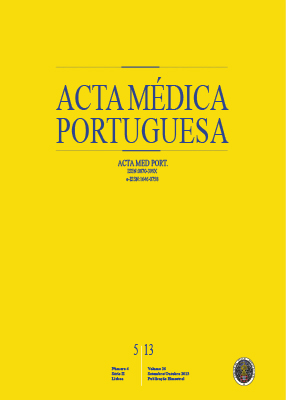Skin Disease in Liver and Kidney Transplant Recipients Referred to the Department of Dermatology and Venereology
DOI:
https://doi.org/10.20344/amp.412Abstract
Introduction: Several skin disorders, immunosuppression-induced, have been described in transplant recipients. The aim of our study is to characterize the clinical spectrum of skin disorders and to compare the findings in liver and kidney transplant recipients.Material and Methods: A retrospective descriptive study was conducted. Data were collected from the medical records of all liver and kidney transplant recipients from 2000 - 2010 who had been referred to our Dermato-Venereology Department.
Results: Three hundred nineteen transplant recipients (23.5%) have been seen, resulting in 410 diagnoses (230 in the subpopulation of liver transplant recipients and 180 in the subpopulation of kidney transplant recipients) grouped into 4 categories: 1) cutaneous infections; 2) skin cancer or premalignant skin lesions; 3) cutaneous side-effects; 4) non-iatrogenic skin disorders. Cutaneous infections were the most common presentations (42.2%), on average 32.7 months after transplantation. The latter group included 20.5% of fungal,
12.7% viral and 8.5% bacterial infections. Skin cancer and premalignant skin lesions made up 11.7% of all diagnoses, over a mean of 44.8 months post transplant and occurring primarily in kidney transplant recipients (20.6% vs 4.8% in liver transplantation patients; P < 0.001). The kidney transplant population had a squamous cell carcinoma (SCC) to basal cell carcinoma (BCC) ratio of 1.3:1 with SCC predominance, and the liver transplant population had a BCC:SCC ratio of 3.5:1. We also identified 10.5% of cutaneous sideeffects and 35.6% of non-iatrogenic skin disorders.
Discussion: Although neoplastic pathology is more frequently mentioned in the literature, cutaneous infections were the most common diagnoses in our study. The significant differences between the two subpopulations studied may be related to higher immunosuppression after kidney transplantation.
Conclusion: The high number of skin disorders reported in these patients makes it essential for Dermato-Venereology to be included within the multidisciplinary post-transplant care provided.
Downloads
Downloads
Published
How to Cite
Issue
Section
License
All the articles published in the AMP are open access and comply with the requirements of funding agencies or academic institutions. The AMP is governed by the terms of the Creative Commons ‘Attribution – Non-Commercial Use - (CC-BY-NC)’ license, regarding the use by third parties.
It is the author’s responsibility to obtain approval for the reproduction of figures, tables, etc. from other publications.
Upon acceptance of an article for publication, the authors will be asked to complete the ICMJE “Copyright Liability and Copyright Sharing Statement “(http://www.actamedicaportuguesa.com/info/AMP-NormasPublicacao.pdf) and the “Declaration of Potential Conflicts of Interest” (http:// www.icmje.org/conflicts-of-interest). An e-mail will be sent to the corresponding author to acknowledge receipt of the manuscript.
After publication, the authors are authorised to make their articles available in repositories of their institutions of origin, as long as they always mention where they were published and according to the Creative Commons license.









